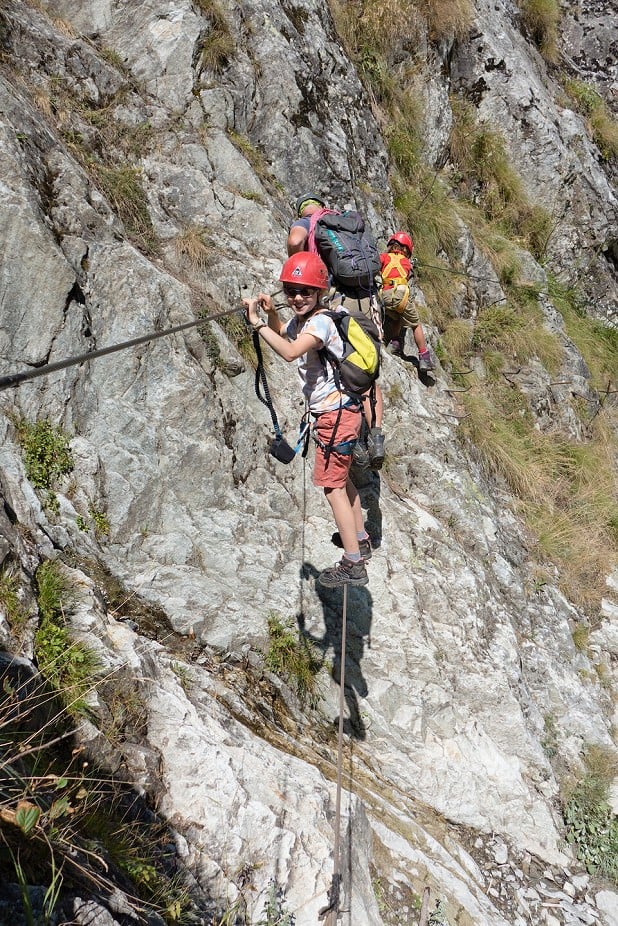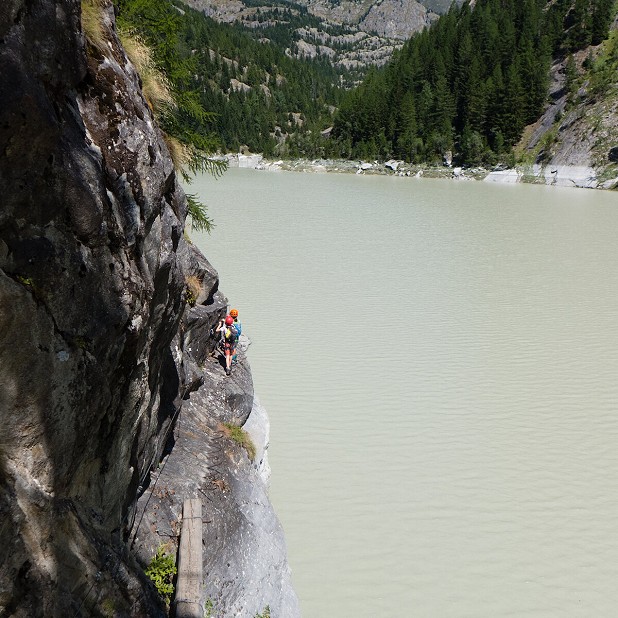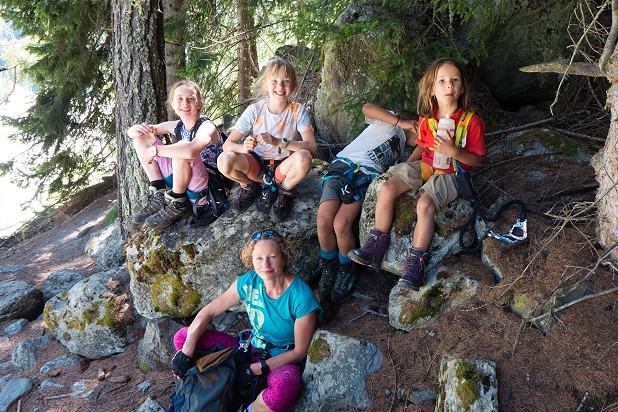Family Days on Iron Ways: Taking on a Via Ferrata with kids
Sam Walmsley talks us through the challenges you can expect, both psychical and emotional, when taking on a Via Ferrata with young children.
The Child's View
Erin - 9 years old.
In August 2022 my family and I went on holiday to Switzerland for one week, and did numerous outdoor activities during the stay. We stayed in a mountain hut. One of the activities we did was Via Ferrata.
So, what is Via Ferrata? Via Ferrata started in the Dolomites (Italy) during the first world war. Soldiers fighting in the mountains fixed metal wires and ladders to cliff faces so they could move around more easily to spy on enemies. Via Ferrata is now a popular sport, some routes still consist of a mixture of fixed equipment such as metal and wooden bridges, ladders, and fixed ropes but you may find many other obstacles. Those that take part in this sport should keep themselves safe by wearing a helmet, harness, gloves, and most importantly two karabiners on slings to secure themselves to fixed wire throughout the route.
This was the first time I had ever tried Via Ferrata and found it very fun. I had to focus every minute of the activity and think about where I put my feet to stay balanced. My muscles were exhausted by the end of the seven-hour adventure. I felt very proud of myself as there are many exposed sections on thin logs and wires 20 metres above the water. It gave me a massive adrenaline rush, but I stayed focused and loved the experience. I recommend it to anyone who loves a challenge and an adventure.
The Parent's View
Sam - 42 years old.
Wiser men than me quote great philosophers, I stick to pop culture. In Jurassic Park, Jeff Goldblum said 'Your scientists were so preoccupied with whether or not they could, they didn't stop to think if they should'. 3 hours into a Swiss via ferrata with our kids, a similar thought was running through my mind.
Our day on the wires begins with a family holiday to Switzerland, visiting Mark, an old climbing club friend, and his family. The addition of wives, children, and middle age meant that our previous preference for drinking heavily, a little nakedness for the benefit of bystanders, then climbing hungover needed to be replaced by more wholesome, inclusive activities.
With four junior members of the party ranging in age from 5-11, all reasonably fit, used to being out in the hills and hanging off rock faces on ropes, via ferrata looked like a great choice for a mountain-orientated, family friendly day out.
Mark had selected the Aletsch VF as a suitable destination. The via ferrata circumnavigates the icy blue Gibidium Lake in southern Switzerland, making the most of the cliffs that surround it. Tricky enough to provide a challenge, long enough to fill the day and with lots of traversing and not too many ladders, it looked like an ideal choice. The abundance of traversing was a key factor in picking a destination because, as discussed in more detail below, younger kids don't weigh enough to activate the shock absorption mechanism in Via Ferrata lanyards, and anything other than a gentle slump onto the wires has potential to break their bodies, their equipment, or both.
In classic British Alpine style, we arrived at the start of the route an hour and a half later than planned. This was mainly the result of my wife and I taking the 'easy to follow' shepherds' path down from the mountain hamlet where we were staying to the car park in the valley floor, several hundred metres below our chalet. Although this trip saved £20 of cable car tickets, it also involved dangling off fixed ropes, vertical grass, gentle doubts from my wife about my navigation skills and, possibly, her marital choices. On reaching the car our adrenaline reserves were already a little depleted.
Inevitably and quite properly, the children started the day full of enthusiasm, lots of cheerful smiles and twinkling eyes. Harnesses and helmets were donned, sunscreen applied, and they impatiently listened as they were given a safety talk which boiled down to 'Always keep at least one lanyard attached, listen to the adults, and always keep at least one lanyard attached'.
Within a couple of minutes it became clear that 5-year-olds take a while to grasp the meaning of 'Always keep one lanyard attached', and a couple of lunges from adult hands onto the lanyards were necessary to avoid child-via-ferrata-soloing becoming a thing. This was clearly of more concern to the adults than young Iona, and we were relieved that after 15 minutes or so she got herself properly co-ordinated, although she was kept very close to an adult throughout the day.
The other kids, Finlay (8), Erin (9) and Anya (11) could be fully trusted within a couple of minutes of being on the wires and were allowed to forge their own trail as long as they stayed within shouting distance of the adults. The day was officially underway.
A blow-by-blow account of 3.5km of via ferrata is as appealing as a boastful Christmas letter from a distant relative, but the following highlights deserve a mention:
- Children should not run across via ferrata suspension bridges. If they do it's likely they'll trip. All adults present will be glad they only cut their knee and did not bounce off the bridge and end up suspended by their VF lanyard 20m above a glacial river with chunks of ice floating in it. It is not likely that said child would have enjoyed this.
- Via Ferrata log bridges may not be designed for 5-year-olds. Adults can use the guard wire both for protection and as a handrail. Young ladies may be too short to reach the handrail and have to teeter across the log above a 30m drop using just their balance. Iona handled it with aplomb. Many would not have (probably including me).
- There is nothing, literally nothing, to make the blood run cold like hearing a terrified scream from a child come round a steep rocky corner, and then nothing more. Fortunately they had only slipped, fallen onto their lanyard and slid a short distance, mostly horizontally, along the guard wire. The 10 seconds between hearing the scream and fully confirming they were ok gave me plenty of time to wonder whether kids really belong on via ferrata.
- All children arrived at the end of the via ferrata with wide smiles and telling tales of a great day. Although I also had a brilliant day, I was pretty psychologically exhausted. I've always loved climbing, but I do find it emotionally draining. Adding constant low-level concern about the safety of all the children in the group definitely took even more out of me. I was extremely relieved when we finally got into the car and I could relax.
As a parent it's easy to ask the question 'Is my kid old enough for via ferrata?', I know I did. With hindsight, although age and weight have to be considered, they are definitely not the key factors in assessing whether the day is going to be safe and successful. First consideration has to be whether your kids are going to enjoy it. Many won't and that's absolutely fine, there are a million other ways to have fun on holiday. If you think they will, the second consideration should be a realistic assessment of what's going to happen if they get halfway round and decide that they are no longer enjoying it. Any of the three incidents above had the potential to take kids from having a huge and happy adventure to just being terrified in a matter of seconds. It will be a slower burn, but hunger and tiredness could have the same effect, draining the enthusiasm and replacing it with misery. Are you confident that you can talk your exhausted, scared child into digging a bit deeper and pushing on back to the car? If your family day out doesn't go smoothly will they be over it after a couple of hot chocolates and a good night's sleep, or is it going to mean nightmares and a lasting feeling of failure? At 5 years old Iona was brilliant company on our day out, but I don't think either of my girls would have enjoyed it at her age, actually I think they would have hated it and potentially been really traumatised by the experience. Do you know your kids and yourself well enough to make these calls? These are the real questions that need answering before heading out on a family via ferrata trip.
More broadly, taking our kids on via ferrata, their longest ever 'climbing' trip made me wonder whether I really wanted to encourage them into this sport. It made me think of the mountain adventures and misadventures of my younger years. Falling into crevasses, blocks of ice hitting my face and sending me to A&E, hallucinating through dehydration in the Bolivian Andes. Events that were inconsequential, the loose flake that stayed in place, the crap gear that somehow held a fall or the dodgy belay that never had to hold a fall. A January week in Scotland where there was so much sketchiness that we became bored of being scared, adrenaline so depleted that yet another pitch devoid of protection just left the brain whispering 'can't believe that yet again, for the 20th time this week, you've misjudged your appetite for adventure. How about tomorrow, just for once, you make better decisions about what to do with the day?'
And then I think of everything the mountains have given me, the sunrises and sunsets, blue skies over blazing snow, the days where everything is on the edge but under control, and most of all the people I've met and the friends I've made. As a parent my biggest hope is that my kids find something, anything, that brings as much to their life as climbing has to mine, because if they do, everything else has a much better chance of falling into place.
The Professional's View
Kevin Avery - 42 years old, fully qualified guide for 3.5 years.
www.truenorthalpine.com
Via Ferrata lanyards have a minimum weight rating. This will vary from manufacturer to manufacturer, but you're very unlikely to find any suitable for people weighing less than 40kg, i.e. most smaller children. The lanyards can still be used for attachment and to hold a slump onto the wire, but won't absorb any shock loads e.g. falling while climbing a ladder. This means that in any situation where there is potential for a vertical fall or shock load, you'll need to keep anyone who's under the weight rating for their lanyard belayed in exactly the same way as you would if they were climbing. It's important to note however, that, for anyone, falling onto a VF lanyard is likely to be highly unpleasant, and is best avoided! Most lanyards have a 'short link' attachment point which is non-dynamic and useful for clipping directly into rungs etc, should you require a rest at any point.
With lots of bolts and other anchors around, placing protection is likely to be very easy when moving roped (it's worth carrying a couple of quickdraws) but you need to bear in mind that you'll be hugely slower than a VF user who's just moving their lanyard as they go.
For belaying or moving together, you'll need a climbing rope. Solid belay anchors every few meters mean that rope length isn't critical, but 20m is a good compromise between weight and having enough length to get past key obstacles. If you've picked a VF with lots of ladders, wearing the rope in coils (alpine style around the shoulder) will save time and faff when adjusting the length of the rope.
It's important to know that, unlike family friendly high ropes courses such as Go Ape, there's nothing to stop a child from unclipping both their lanyards simultaneously, instantly placing them in a life-threatening situation. Kids will not be able to fully recognise this danger, and will need close supervision until you're 100% confident that they will keep themselves attached at all times.
You should keep them connected to you with a short section of dynamic rope while they get the hang of transferring the lanyards past anchors and always closely supervise them.
Along with the via ferrata lanyard, everyone taking part will need a helmet, climbing harness appropriate for their age (this may mean full body harness for smaller kids) and appropriate footwear (sturdy trainers work fine). It's also wise to take gloves for everyone (basic leather belaying gloves work well) as holding onto metal wires and rungs can become pretty uncomfortable without them.
As with any mountain adventure, you'll also need to think about which non-technical safety essentials go into the rucksack. As a minimum that means appropriate clothing, food, water, sunscreen and a headtorch, plus a mobile phone in case of emergencies.
Although via ferrata can be safe, you will be in an environment which is not benign and you need to be prepared for reasonably foreseeable problems, including hungry, tired, grumpy children, and a late return to the car.





